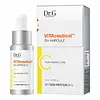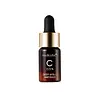What's inside
What's inside
 Key Ingredients
Key Ingredients

 Benefits
Benefits

 Concerns
Concerns

 Ingredients Side-by-side
Ingredients Side-by-side

Water
Skin ConditioningTerminalia Ferdinandiana Fruit Extract
AntioxidantAscorbic Acid 15%
AntioxidantEthoxydiglycol
HumectantGlycerin
HumectantMethyl Gluceth-20
Humectant1,2-Hexanediol
Skin ConditioningC12-13 Pareth-9
EmulsifyingTromethamine
BufferingAcetyl Glucosamine
Skin ConditioningTocopherol 1%
AntioxidantPanthenol 1%
Skin ConditioningBisabolol
MaskingPinus Pinaster Bark Extract
AntioxidantFerulic Acid
AntimicrobialButylene Glycol
HumectantPentylene Glycol
Skin ConditioningTroxerutin
Skin ConditioningDisodium EDTA
Oenothera Biennis Oil
EmollientSodium Hyaluronate
HumectantAdenosine
Skin ConditioningXanthan Gum
EmulsifyingHydroxyphenyl Propamidobenzoic Acid
Skin ConditioningPropanediol
SolventResveratrol
AntioxidantAnthemis Nobilis Flower Extract
MaskingBuddleja Officinalis Flower Extract
UV FilterAscorbyl Palmitate 0.001%
AntioxidantWater, Terminalia Ferdinandiana Fruit Extract, Ascorbic Acid 15%, Ethoxydiglycol, Glycerin, Methyl Gluceth-20, 1,2-Hexanediol, C12-13 Pareth-9, Tromethamine, Acetyl Glucosamine, Tocopherol 1%, Panthenol 1%, Bisabolol, Pinus Pinaster Bark Extract, Ferulic Acid, Butylene Glycol, Pentylene Glycol, Troxerutin, Disodium EDTA, Oenothera Biennis Oil, Sodium Hyaluronate, Adenosine, Xanthan Gum, Hydroxyphenyl Propamidobenzoic Acid, Propanediol, Resveratrol, Anthemis Nobilis Flower Extract, Buddleja Officinalis Flower Extract, Ascorbyl Palmitate 0.001%
Water
Skin ConditioningAscorbic Acid
AntioxidantButylene Glycol
HumectantDipropylene Glycol
HumectantPropanediol
SolventDicaprylyl Carbonate
EmollientPropylene Glycol Dicaprylate
EmollientIsopropyl Oleate
EmollientIsopropyl Sorbate
AntimicrobialPolysorbate 60
EmulsifyingGlutathione
Glycerin
HumectantAlpha-Ionol
PerfumingGlyceryl Stearate
EmollientPanthenol
Skin ConditioningCitric Acid
BufferingChitosan
Pullulan
Sodium Gluconate
Skin ConditioningSodium Hyaluronate
HumectantHelianthus Annuus Seed Oil
EmollientDimethicone
EmollientEthylhexyl Methoxycinnamate
UV AbsorberCetrimonium Chloride
AntimicrobialSodium Chloride
MaskingVigna Radiata Seed Extract
Skin ConditioningHydrolyzed Grape Fruit Extract
HumectantEclipta Prostrata Extract
Skin ConditioningGlycine Soja Seed Extract
Skin ConditioningBeta-Carotene
Skin ConditioningDaucus Carota Sativa Seed Oil
EmollientCurcuma Longa Root Extract
MaskingTerminalia Ferdinandiana Fruit Extract
AntioxidantBeta-Glucan
Skin ConditioningBetula Alba Bark Extract
MaskingUlmus Davidiana Root Extract
Skin ConditioningSodium Alum
AstringentWater, Ascorbic Acid, Butylene Glycol, Dipropylene Glycol, Propanediol, Dicaprylyl Carbonate, Propylene Glycol Dicaprylate, Isopropyl Oleate, Isopropyl Sorbate, Polysorbate 60, Glutathione, Glycerin, Alpha-Ionol, Glyceryl Stearate, Panthenol, Citric Acid, Chitosan, Pullulan, Sodium Gluconate, Sodium Hyaluronate, Helianthus Annuus Seed Oil, Dimethicone, Ethylhexyl Methoxycinnamate, Cetrimonium Chloride, Sodium Chloride, Vigna Radiata Seed Extract, Hydrolyzed Grape Fruit Extract, Eclipta Prostrata Extract, Glycine Soja Seed Extract, Beta-Carotene, Daucus Carota Sativa Seed Oil, Curcuma Longa Root Extract, Terminalia Ferdinandiana Fruit Extract, Beta-Glucan, Betula Alba Bark Extract, Ulmus Davidiana Root Extract, Sodium Alum
Ingredients Explained
These ingredients are found in both products.
Ingredients higher up in an ingredient list are typically present in a larger amount.
Ascorbic Acid is is pure Vitamin C. This form makes up the largest amount of vitamin C found naturally in our skin.
Not only is vitamin C great for your overall health and immune system, it also has plenty of benefits on your skin.
Vitamin C is best used for brightening skin. It improves dark spots, acne scars, and hyperpigmentation. This is because it blocks the process of skin darkening when exposed to UV.
Remember: Vitamin C should not replace sunscreen!
Your skin uses vitamin C to build collagen. Collagen is one key component in having a strong skin barrier and plump skin. Vitamin C also plays a role in regulating collagen, thus making it effective in improving wrinkles and fine lines.
Ascorbic acid shows potent antioxidant activity. As an antioxidant, it helps fight free-radicals. Free-radicals are molecules that may damage your skin cells. These antioxidants also protect skin against UV damage.
The best formulations include Vitamin E and/or ferulic acid. These two ingredients help stabilize and provide a boost in the benefits of ascorbic acid. This is because ascorbic acid becomes unstable when exposed to UV and air. In fact, you can tell your ascorbic acid has oxidized when it turns an orange-yellow color.
Ascorbic acid is generally compatible with other ingredients. However, using ascorbic acid with other active ingredients might cause irritation. Two ingredients: copper ions and benzoyl peroxide, will inactivate ascorbic acid completely.
Read more about other types of Vitamin C:
Foods rich with vitamin C include oranges, strawberries, broccoli, bell peppers, and more. When consuming Vitamin C, your skin receives a portion of the nutrients.
Learn more about Ascorbic AcidButylene Glycol (or BG) is used within cosmetic products for a few different reasons:
Overall, Butylene Glycol is a safe and well-rounded ingredient that works well with other ingredients.
Though this ingredient works well with most skin types, some people with sensitive skin may experience a reaction such as allergic rashes, closed comedones, or itchiness.
Learn more about Butylene GlycolGlycerin is already naturally found in your skin. It helps moisturize and protect your skin.
A study from 2016 found glycerin to be more effective as a humectant than AHAs and hyaluronic acid.
As a humectant, it helps the skin stay hydrated by pulling moisture to your skin. The low molecular weight of glycerin allows it to pull moisture into the deeper layers of your skin.
Hydrated skin improves your skin barrier; Your skin barrier helps protect against irritants and bacteria.
Glycerin has also been found to have antimicrobial and antiviral properties. Due to these properties, glycerin is often used in wound and burn treatments.
In cosmetics, glycerin is usually derived from plants such as soybean or palm. However, it can also be sourced from animals, such as tallow or animal fat.
This ingredient is organic, colorless, odorless, and non-toxic.
Glycerin is the name for this ingredient in American English. British English uses Glycerol/Glycerine.
Learn more about GlycerinPanthenol is a common ingredient that helps hydrate and soothe the skin. It is found naturally in our skin and hair.
There are two forms of panthenol: D and L.
D-panthenol is also known as dexpanthenol. Most cosmetics use dexpanthenol or a mixture of D and L-panthenol.
Panthenol is famous due to its ability to go deeper into the skin's layers. Using this ingredient has numerous pros (and no cons):
Like hyaluronic acid, panthenol is a humectant. Humectants are able to bind and hold large amounts of water to keep skin hydrated.
This ingredient works well for wound healing. It works by increasing tissue in the wound and helps close open wounds.
Once oxidized, panthenol converts to pantothenic acid. Panthothenic acid is found in all living cells.
This ingredient is also referred to as pro-vitamin B5.
Learn more about PanthenolPropanediol is an all-star ingredient. It softens, hydrates, and smooths the skin.
It’s often used to:
Propanediol is not likely to cause sensitivity and considered safe to use. It is derived from corn or petroleum with a clear color and no scent.
Learn more about PropanediolSodium Hyaluronate is hyaluronic acid's salt form. It is commonly derived from the sodium salt of hyaluronic acid.
Like hyaluronic acid, it is great at holding water and acts as a humectant. This makes it a great skin hydrating ingredient.
Sodium Hyaluronate is naturally occurring in our bodies and is mostly found in eye fluid and joints.
These are some other common types of Hyaluronic Acid:
Learn more about Sodium HyaluronateTerminalia Ferdinandiana Fruit Extract is from the Kakadu plum. The Kakadu plum is native to northern Australia. The Kakadu plum holds the record for having the highest amount of natural vitamin C.
This ingredient is an antioxidant. Antioxidants help fight free-radical molecules. Free-radical molecules are capable of damaging our cells and other genetic material. Antioxidants help stabilize free-radicals and thus may reduce the signs of aging.
The high vitamin C content of Kakadu plum also helps lighten skin. Vitamin C has been shown to block the process of skin darkening that leads to hyperpigmentation.
Kakadu plums have been used by indigenous cultures as medicine to help treat colds and as an antiseptic.
Learn more about Terminalia Ferdinandiana Fruit ExtractWater. It's the most common cosmetic ingredient of all. You'll usually see it at the top of ingredient lists, meaning that it makes up the largest part of the product.
So why is it so popular? Water most often acts as a solvent - this means that it helps dissolve other ingredients into the formulation.
You'll also recognize water as that liquid we all need to stay alive. If you see this, drink a glass of water. Stay hydrated!
Learn more about Water